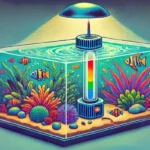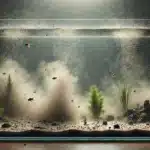Wondering whether or not it’s worth adding CO₂ to your aquarium? If you keep live plants and want consistent and fast growth, then the short answer is a resounding yes. Below, I’ll give a brief overview of what CO₂ does in a fish tank, how to set it up safely, how to measure it, and where most people go wrong with it.
What CO₂ Does for Planted Aquariums
Live aquatic plants need light, nutrients, and carbon to survive and grow. In most tanks, carbon is the limiting factor for plants. Carbon is a necessary component of photosynthesis (how plants make energy), so insufficient available amounts of this for the plant will stall its ability to grow, make energy and repair any damage.
This is where the concept of adding CO2 to your aquarium comes in. By dissolving CO2 within the tank water, more carbon is then available for plants to access, thus enabling them to maximise rates of photosynthesis and growth.
When an aquarium plant has sufficient CO2 available to it, you may notice a constant stream of tiny bubbles coming out from its leaves. This is known as ‘pearling’. Pearling happens when plants produce oxygen faster than it can dissolve into the surrounding water. (Plants produce oxygen as a byproduct of photosynthesis.)
If you have fish in your fish tank, you may be wondering if adding CO2 is needed, as they will already be producing CO2. However, they do not produce nearly enough CO2 for high-demand or densely plants plant growth. An average community tank without CO2 injection may only reach 1–3 ppm CO₂, this is far below the 20–30 ppm level that carpeting plants and red species need to thrive.
Do You Actually Need CO₂ for the plants that you have?
The answer is maybe… and will depend on the type of plant, its colour, and how fast you want to see it grow.
- Low-tech tanks (hardy plants, modest light): CO2 is optional for these situations. Many flourish without CO2 injection, especially those keeping plants like Anubias, Java fern, Java moss and Cryptocoryne.
- High-tech planted tanks (carpeting plants, high light requirements): For these tanks, adding CO₂ is often the difference between the plants “surviving” and “thriving.” Carpeting plants will definitely establish and fill out faster if CO2 is added to the tank. Plants like Amazon swords, Monte Carlo, and Glossostigma all prefer more CO₂.
How to add CO2 to my fish tank
Pressurised systems (CO₂ cylinder + regulator + diffuser) are the go-to products for most people. They are consistent and adjustable, great for stability of aquarium parameters.
DIY yeast setups (CO2 is a byproduct of yeast fermentation). These are much cheaper and often users first experience with CO2. However, they do come with a few cons that are important to be aware of. Namely, the output of CO2 is not consistent, often spiking when the mixture is fresh, then crashes a few days later. This inconsistency will have an impact on water parameters and can stress more sensitive plants and fish.
Liquid carbon is often discussed as an additional option for adding CO2 to your tank, however this is not quite true. These products do not add dissolved CO2 to the tank, instead they usually are made of glutaraldehyde derivatives. As such, there is no readily available CO2 for your plants to use like with the other two methods. But this option does have other good uses in a fish tank, particularly as a way to combat some forms of algae.
When to Run CO₂
Plants only use CO₂ while the lights are on. Therefore, for efficiency and safety it is best to match the CO₂ output with these times:
- Start CO₂ about 30–60 minutes before lights on.
- Stop it 30–60 minutes before lights off.
This avoids any overnight buildup in the tank and matches demand of your plants.
Measuring CO₂ concentration
There are three main methods to do this:
- Drop checker. Fill it with a 4 dKH reference solution (not your tank water). When it turns green, you’re near 30 ppm. Keep in mind that this method can have a lag of 1–2 hours, so don’t expect real-time readings.
- pH-drop method. De-gas a sample to find the true baseline pH, then aim for a ~1.0 drop after CO₂ injection. This methods is more accurate than just plugging numbers into a chart.
- KH/pH charts. The classic formula works in theory but in real tanks other acids and bases can throw it off. For example, both carbonate hardness (KH) and pH are tightly linked to CO₂, but unless KH is pure carbonate, the chart can be misleadin\].
Distribution & Gas Exchange
Two critical but often ignored pieces:
- Flow & distribution. If not set up correctly, plants in dead spots won’t get enough CO₂. It’s best to put your diffuser near the output of your filter or circulation so that CO₂ bubbles spread through the whole tank.
- Surface agitation. Many new users fear this will drive off CO₂. In reality, a gentle ripple keeps oxygen levels high, which lets fish tolerate higher CO₂ safely. The balance between O₂ and CO₂ is more important than holding every bubble in.
Keeping Fish Safe with Added CO2
Will CO₂ hurt my fish? No, not typically, providing CO₂ levels are stable and there is adequate oxygen. Aim for ~20–30 ppm and watch the behavior of your fish.
Signs that there is excess CO₂ in your tank and that your fish are not tolerating those levels include: fish gasping at the surface, clamped fins, or sluggish behavior. If this happens, reduce injection and boost surface agitation to aid gaseous exchange. Keep in mind that water temperature also affects CO₂ solubility. Cooler water holds more gas, warmer water less. So if your summer temps climb, your carefully tuned CO₂ might actually start to drop. So it can always be worth checking if your plants suddenly slowdown in the summer, but keep an eye on your fish as temperatures start to drop back down again.



